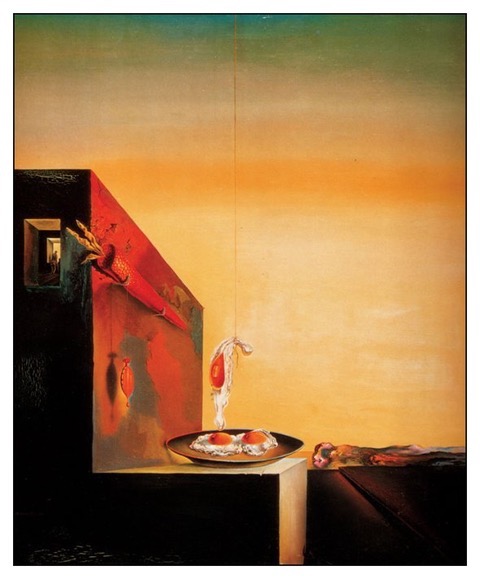I’m not in the habit of writing restaurant reviews but I was so moved by a recent dining experience that I simply had to share it.
I needed to get something to eat in a hurry and decided to check out a local lunch counter that has been doing spectacular business for a couple of years. It is situated on the ground floor of an old apartment building, between a gas station and a vegan bakery. The narrow interior is currently closed but they’re doing a brisk trade through the take-out window, and there is always a crowd of young people standing around in front of it, waiting to photograph their meals.
“Oh my God… this looks amazing… awesome…” cooed the customers in front of me as they surveyed the bill of fare.
The menu that was exciting such impassioned exaltations features a variety of sandwiches inspired by Japanese convenience store cuisine, i.e., the most simple and affordable food available in a Japanese city, the sort of thing one will find at a Tokyo 7-Eleven.
I skipped their signature homage to the iconic Japanese egg salad sando, because eggs are disgusting, and opted for a chicken salad sandwich. “Thank you, brother,” said the server as he handed back my credit card—no cash, of course: cash is unhygienic and passé—and stood around on the hot, dirty, noisy sidewalk waiting for my order.
Clean-cut beardos, accompanied by their inevitable dogs, jabbered into their inevitable Smartphones, and I was privy to a conversation that might have set a new world record for how many times it was possible to jam the words “like” and “cool” into one sentence. Then two flocks of young women merged into each other and immediately started, and didn’t stop, greeting each other with shrieks of joy – “Oh my God! I haven’t seen you in like forever!… Oh my God!”
I retreated to my car and checked the incoming race results at Santa Anita. Fifteen minutes later I was summoned to the window and presented with a small, almost weightless white cardboard box.

Pablo Picasso – The Frugal Meal (1904)
What had we here: a sandwich consisting of a little chicken, a smattering of herbs, and a lot of thick mayonnaise, placed between two pieces of crustless white bread (shokupan, also known as milk bread), and cut into three slices, its insubstantial dimensions fitting snugly into the white cardboard box.
Something seemed to be missing. I checked the receipt: $14 for the sandwich, plus tax, an additional charge for health care (a nice touch), and the 15% I was stupid enough to tip them. That’s more than $18 – without drink or sides, from a take-out window. The bill included as many add-ons as possible but nothing extra was added to the meal. The fix was on.
I don’t mean to appear greedy but isn’t it customary to receive at least one side dish with a sandwich? I looked around at the other grazers, who all looked weirdly content as they nibbled on their sandos, and felt as if I’d entered the culinary equivalent of The Stepford Wives. Most of them had small side dishes. I checked the menu again. Yes, even the pickles cost extra: they’re vegan, naturally… but aren’t pickles already vegan, naturally?
I looked at the sandwich in my hand and it made me feel sad – not only for the state of my stomach but for the state of the world. I might as well eat the damn thing, as a form of penance for being enough of a sucker to buy it in the first place.
Nine bites later and it was all over. The sando had taken two minutes to consume. Yes, it was a perfectly adequate hors d’oeuvre. But this meager fare was hardly enough to keep body and spirit intact. The only thing it filled me with was Weltschmerz.
Ultimately it was all about the white cardboard box. If the sando had been presented in a brown bag, like a normal deli sandwich, or even shrink-wrapped à la the original Japanese convenience store model, nobody would take it seriously. Such photogenic finger food might be sufficient for a dieting model—and by the looks of it, this genus makes up a significant proportion of the clientele—but not for those who sustain themselves on the bread and meat of life.
Was it all some sort of cruel joke? No, they weren’t kidding, and the line at the window was lengthening. The place was patronized by the sort of carriage trade that prefer to pay top dollar; they find it ennobling. Only in a bourgeois bohemian enclave can such smug gastronomical chicanery fly. The name itself should have given the game away, for a con it be.

Salvador Dali – Eggs on the Plate (Without the Plate) (1932)
At a Mexican restaurant on the next block, I could have sat in a plush Naugahyde booth and paid the same price for a lavish meal while being serenaded by mariachi musicians. Unfortunately, it was too late for that now. However, there was a pizzeria nearby, and there I went, still famished, to fortify myself on something more satisfying.
The world has gone mad, of course. There doesn’t seem to be much use in pointing that out anymore – it’s old news, but one is given fresh cause to be amazed by it on such a frequent basis that it is difficult not to continually bemoan the current state of things with renewed vigor.
It’s not only Japanese convenience store sandwiches that are being re-imagined as designer food by upgrading the package while the product remains essentially the same. Every kind of normal street fare—bratwurst, coffee, bagels, toast, cider, ad infinitum—that already existed in a more modest form is presented as if it’s some sort of rarefied delicacy that we ought to feel privileged to partake of.
Nothing can just be itself anymore. From avocado toast emporiums to faux-dive bars and boutique hotels (which lack the amenities of a regular hotel but sell themselves as being something more), such rip-offeries are the norm nowadays: fetishized and effete versions of their former selves, and not just overpriced but obscenely priced. As much is charged as they can possibly get away with, and they can get away with a lot.
Don’t worry, this mean-spirited review isn’t going to hurt anybody’s business; they can take it. The eatery in question was voted one the ten best new restaurants in the country by Bon Appetit magazine. Apparently their ‘take’ on the chocolate croissant is ‘amazing’. I shouldn’t be bashing a ‘neighborhood’ place. They’re just trying to make an honest dollar by giving the people what they want – and this, confoundingly, is what they want.
The new neighborhood, that is. Two blocks down the street, a hearty sandwich can be had for a third of the price at a longstanding burger joint. But not for much longer. It’s closing next month. The only affordable place in the entire neighborhood has finally been priced out of business by the demand for less.
Less is more, and they can’t get enough of it.


